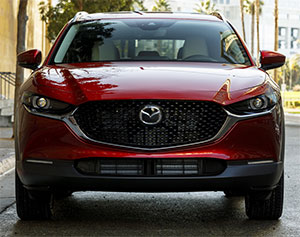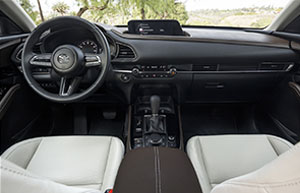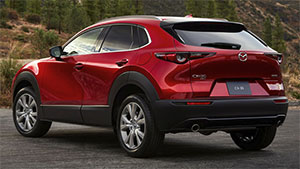2020 Mazda CX-30
“Why in the world would they need that?” may be your first question when you hear that Mazda would be adding another small crossover into their lineup, the CX-30. And “why would they mess up a seemingly logical naming pattern of CX-3’s, 5’s, and 9’s?” may be your next one. Well those are some great questions; let’s see if we can provide some great answers.
These days, if you still have a sedan in your lineup, there’d better be an SUV based on the same platform. And if you can get two SUVs on that platform, well, all the better. And that’s where this all-new 2020 Mazda CX-30 comes in; wedged in the lineup between the CX-3 and its larger engineering cousin CX-5. I guess calling it a CX-4 would have been too easy. Or is it just 10-times better than the CX-3?
The Mazda3 has always been a favorite here at MotorWeek, so having another crossover sharing its bones is certainly not a bad thing.
 And the engine is the same SKYACTIV-G 2.5-liter I4 found in both the Mazda3 and CX-5. Now, Mazda claims it has been tuned specifically for the CX-30, but with the same 186-horsepower and 186 lb-ft. of torque, the retuning must be very minimal; regardless, those numbers are very stout for the segment. Premium trim adds cylinder deactivation for improved fuel economy.
And the engine is the same SKYACTIV-G 2.5-liter I4 found in both the Mazda3 and CX-5. Now, Mazda claims it has been tuned specifically for the CX-30, but with the same 186-horsepower and 186 lb-ft. of torque, the retuning must be very minimal; regardless, those numbers are very stout for the segment. Premium trim adds cylinder deactivation for improved fuel economy.
A 6-speed auto handles transmission duty, with front-wheel-drive standard, and all-wheel-drive available. Our AWD tester felt quite peppy on the street, with smooth steering, and better than typical Mazda ride quality.
Things are certainly cozy inside, but not tight; and the clean design definitely has a near luxury feel in our Premium packaged test car.
All trims get a dash-top 8.8-inch screen for Mazda Connect infotainment; controlled by the typical console-mounted controller. A multi-function knob for the radio is also on the console, while HVAC controls are integrated into the slender dash.
Everything is within easy reach, and if you’re already used to Mazda’s way of doing things, you’ll feel right at home.
One side note, if you’re into door rattling bass; you’ll be disappointed, as Mazda actually mounted the woofers in the body of the car to prevent just that.
 Now, front seats are firm to put it mildly; so the CX-5 is comfier for long trips. But around town, the CX-30 shines.
Now, front seats are firm to put it mildly; so the CX-5 is comfier for long trips. But around town, the CX-30 shines.
Rear seat room is marginal for adults, but about par for a subcompact; and just a tiny bit more than the Mazda3 hatchback.
Unlike the CX-3, the CX-30 feels like a real utility when it comes time to throw stuff into the cargo hold. Also, its 20.2 cubic-ft. of space is about 2/3rds of the CX-5’s. Split folding seatbacks are standard.
As for ¼-mile sprints, there’s some decent power for getting off the line, but no big hits or surges that you might get with a smaller turbo. Just a slow and steady build as you work your way to 60 in 8.0-seconds flat.
Things are fairly quiet inside, and the engine noise that you do hear is relatively pleasant. Shifts from the 6-speed auto are very smooth; and the ¼-mile took us 16.0-seconds to complete at 87 miles-per-hour.
Provided we weren’t too aggressive with inputs, there was plenty of fun to be had through our cone course, but traction control can end the party quickly. Still, Mazda prides itself on delivering an entertaining and sporting driving experience throughout their lineup, and the CX-30 was as enjoyable as we expected.
 Sport mode just seems to let you rev the engine higher, as there are no active suspension elements; but there is G-Vectoring Control Plus, which is Mazda’s fancy name for handling assist by way of selective braking.
Sport mode just seems to let you rev the engine higher, as there are no active suspension elements; but there is G-Vectoring Control Plus, which is Mazda’s fancy name for handling assist by way of selective braking.
Average straight-line braking distance from 60 was just 98-feet; feeling very stable throughout, with smooth and straight stops, and no fade to speak of.
Mazda’s Kodo design theme will probably make a few people stop in their tracks as well. The simplistic big mouth front, and undulating sides are certainly a notch above most in the segment.
Blind Spot Monitoring is optional, but standard i-Activesense safety features include radar cruise with stop-and-go, as well as Lane-Keep Assist.
Government Fuel Economy Ratings for all-wheel-drive with Premium trim are 25-City, 32-Highway, and 27-Combined. We averaged 30 miles-per-gallon of Regular. And that’s a better than average Energy Impact Score of 12.2-barrels of yearly oil use, with CO2 emissions of 5.3-tons.
Pricing starts at only $23,000, which is about 3-grand less than the CX-5, and $1,000 less than a Mazda3 hatchback. All-wheel-drive adds $1,400 more, with top Premium trim coming in at $29,300.
There is a lot to like about the 2020 Mazda CX-30. While it was clearly designed with the young active buyer in mind, it goes above and beyond that, and would make a great utility regardless of age or activity level. That makes it a winner in our book, and proof that there was indeed room for one more utility in the Mazda lineup.
Specifications
- Engine: 2.5 liter
- Horsepower: 186
- Torque: 186 lb-ft.
- 0-60 mph: 8.0 seconds
- 1/4 mile: 16.0 seconds @ 87 mph
- EPA: 25 mpg city / 32 mpg highway
- Energy Impact: 12.2 barrels of oil/yr
- CO2 Emissions: 5.3 tons/yr






